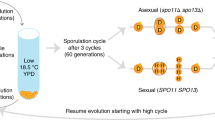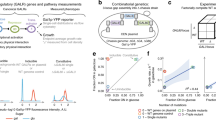Abstract
Ustilago violacea has a simple bipolar heterothallic mating system, with two alleles a1 and a2 of the mating-type locus. Haploid yeast-like cells of opposite mating type conjugate on a medium free of nutrients1. Earlier reports from this laboratory using diploid, triploid and tetraploid cells showed that allele a2 is dominant in log phase cultures (heterozygous cells conjugate with cells homozygous for a1 but not cells homozygous for a2). Heterozygous cells in stationary phase cultures failed to mate even though all the stationary phase homozygous cells mated actively. Consequently, the dlominance of allele a2 is termed age-related2.
This is a preview of subscription content, access via your institution
Access options
Subscribe to this journal
Receive 51 print issues and online access
$199.00 per year
only $3.90 per issue
Buy this article
- Purchase on Springer Link
- Instant access to full article PDF
Prices may be subject to local taxes which are calculated during checkout
Similar content being viewed by others
References
Day, A. W., and Jones, J. K., Genet. Res., 2, 63 (1968).
Day, A. W., Nature new Biol., 237, 282 (1972).
Cummins, J. E., and Day, A. W., Nature, 245, 259 (1973).
Wells, J. R., and James, T. W., Expl Cell Res., 75, 465 (1972).
Author information
Authors and Affiliations
Rights and permissions
About this article
Cite this article
DAY, A., CUMMINS, J. Temporal Allelic Interaction, a New Kind of Dominance. Nature 245, 260–261 (1973). https://doi.org/10.1038/245260a0
Received:
Revised:
Issue Date:
DOI: https://doi.org/10.1038/245260a0
Comments
By submitting a comment you agree to abide by our Terms and Community Guidelines. If you find something abusive or that does not comply with our terms or guidelines please flag it as inappropriate.



